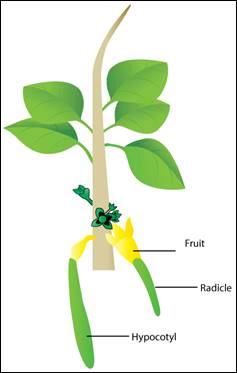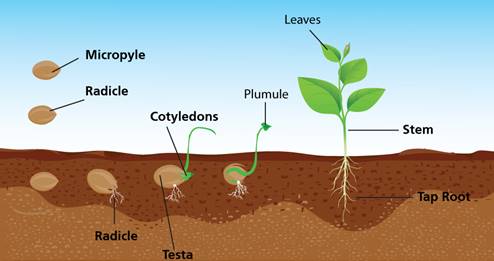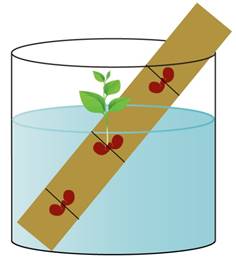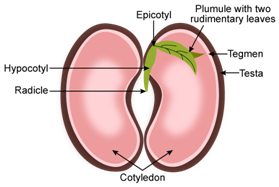Class 9 SELINA Solutions Biology Chapter 6: Seeds: Structure and Germination
Seeds: Structure and Germination Exercise Ex. 1
Solution A.1(a)
(iii) Maize grain……coleoptile
Solution A.1(b)
(iv) do not get enough oxygen
Solution A.1(c)
(i) Ovary
Solution A.1(d)
(iii) Double coconut
Solution A.1(e)
(iii) Hilum
Solution A.1(f)
(ii) Scutellum
Solution A.1(g)
(i) Testa
Solution A.1(h)
(iv) Radicle
Solution A.1(i)
(iv) All of the above
Solution A.1(j)
(iv) Hypogeal germination
Solution B.1
(a) Radicle develops into the root system.
(b) Tegmen is the thin inner layer of the seed coat.
(c) Epithelium separates the endosperm and embryonic region in the maize grain.
(d) Epicotyl elongates faster in hypogeal germination.
(e) Germination is the period of rest in an embryo.
Solution B.2
(a) Maize
(b) Pyrogallic acid
(c) Shoot
(d) Rhizophora
(e) Aleurone layer
(f) Bean
Solution B.3
(a) In bean seeds, plumule grows faster and the seeds are brought above ground.
(b) Coleorhiza is a protective layer of radicle and coleoptile protects the rolled plumule.
(c) A seed is protected by seed coat and testa.
(d) Seeds absorb water through micropyle which also helps in diffusion of respiratory gases.
(e) Rich, wheat and maize are rich in starch food.
Solution B.4
(a) Micropyle, 1st male gamete, egg cell, zygote, embryo
(b) Allogamy, fusion of gametes, zygote, embryo, seed
(c) Testa, Tegmen, Cotyledons, Embryonic axis
Solution B.5
(a) Monocot albuminous seed: Bamboo and wheat
(b) Monocot non-endospermic seed: Vallisneria and orchid
(c) Dicot non-endospermic seed: Mango and pea
(d) Viviparous plants: Rhizophora and Sonneratia
Solution B.6
| Column A | Column B |
| (a) Coleoptile | (iv) Plumue |
| (b) Coleorhiza | (iii) Radicle |
| (c) Radicle | (i) Root system |
| (d) Plumule | (v) Shoot system |
| (e) Scutellum | (ii) Cotyledon |
Solution B.7
(a) Monocotyledonous seeds and Dicotyledonous seeds
(b) Albuminous (endospermic) seeds and Exalbuminous (non-endospermic) seeds
(c) Water, Suitable temperature and Oxygen
(d) Hypogeal germination and Epigeal germination
(e) Testa and Tegmen
Solution C.1
(a) Seed: Seed is the ripened ovule that contains an embryo or a miniature immature plant as well as food reserves, all protected by a seed coat.
(b) Fruit: Fruit is an enlarged, fleshy or dry ripened ovary of a flowering plant, enclosing the seed or seeds.
(c) Grain: Grain is a fruit in which the fruit wall and the seed coat are fused together to form a protective layer.
(d) Dormancy: Dormancy is defined as the period of rest or temporary inability of a viable seed to germinate under favorable environmental conditions.
(e) Germination: Germination is the process of formation of a seedling developed from the embryo.
Solution C.2
A seed is a mature ovule after fertilization. It contains a tiny living-plant called the embryo. The embryo within the seed remains in an inactive or dormant state, until it is exposed to favourable conditions, when it germinates.
Solution C.3
Germinated grams are considered highly nutritive because the cotyledon of the seed absorbs food from the endosperm, making it nutritive. It is rich in starch and its outermost layer is rich in protein.
Solution C.4
Maize grain is actually a fruit in which the fruit wall and the seed coat are fused together to form a protective layer. Therefore, we do not use the terms maize fruit and maize seed. Instead, we call such fruits as grains.
Solution D.1
(a) Differences between monocotyledonous and dicotyledonous seeds:
|
Monocotyledonous seed |
Dicotyledonous seed |
|
|
|
|
(b) Differences between epicotyl and hypocotyl:
|
Epicotyl |
Hypocotyl |
|
|
|
|
(c) Differences between epigeal and hypogeal germination:
|
Epigeal Germination |
Hypogeal Germination |
|
|
|
|
(d) Differences between radicle and plumule:
|
Radicle |
Plumule |
|
|
|
|
(e) Differences between albuminous and exalbuminous seeds:
|
Albuminous seeds |
Exalbuminous seeds |
|
|
|
|
Solution D.2
(a) Seed coat: It protects the delicate inner parts of the seed from injury and the attack of bacteria, fungi and insects.
(b) Micropyle: During germination, micropyle allows water to enter the seed through its pore.
(c) Cotyledons: They contain food for the embryo.
(d) Radicle: It forms the future root.
(e) Plumule: It forms the future shoot.
Solution D.3
Aim: To prove that a suitable temperature is necessary for germination.
Apparatus: Two beakers, wet cotton wool, refrigerator
Procedure:
(1) Take two beakers and label them as A and B.
(2) Place some gram seeds on wet cotton wool in each of the beakers.
(3) Keep beaker A at ordinary room temperature and beaker B in the refrigerator.
(4) In 1-2 days, the seeds in beaker A will germinate, showing the importance of a suitable temperature for germination. Seeds in beaker B may not show the signs of germination or may germinate after several days, though not to the extent as the seeds in beaker A.
Inference: Seeds require a suitable temperature for germination.
Solution D.4
Yes, we call it germination because all the changes leading to the formation of a seedling collectively constitute germination. During germination, either the epicotyl or the hypocotyl elongates.
Solution D.5
(a) Differences between coleorhiza and coleoptile:
|
Coleorhiza |
Coleoptile |
|
|
|
|
(b) Differences between bean seed and maize grain:
|
Bean seed |
Maize grain |
|
|
|
|
(c) Differences between germination and vivipary:
|
Germination |
Vivipary |
|
|
|
|
Solution D.6
A fruit is the enlarged ripened ovary in which the ovarian wall forms the fruit wall and encloses the seed. The fruit protects the seed and helps in seed dispersal.
The maize grain is regarded as a 'one-seeded fruit' because the fruit wall and the seed coat are fused to form a protective layer. Such a fruit is called grain.
Solution D.7
Germination of a seed which takes place above the ground is called epigeal germination. In epigeal germination, the hypocotyl grows forming a loop above the soil. It then straightens pushing the cotyledons above the ground.
Solution D.8
(a) A twig of viviparous plant showing its germination

(b) A seedling growing in soil

Solution D.9
Experimental set-up of three-bean seed experiment

Water, suitable temperature, and oxygen are conditions necessary for germination.
Water
• When water enters the seed, it activates the enzymes present in the seed. These enzymes mobilise the reserve food and break it into simpler forms. This food is utilised by the embryo, and the embryo begins to grow.
• Water causes the seed coat to swell and rupture. The growing embryo then emerges out through the ruptured seed coat.
Temperature
• A suitable temperature is required for the seeds to germinate.
• Very high temperatures destroy the delicate tissues inside the seed, while low temperatures slow down the growth and development of the embryo.
• A moderate temperature, ranging from 25°C to 35°C is favourable for the seeds to germinate. Such a temperature is known as optimum temperature.
Oxygen
• Rapid cell division and cell growth occur during the process of seed germination. This process requires energy. This energy is provided by the oxidation of food.
• Oxidation of food occurs through respiration, which requires oxygen.
Solution E.1
(a) The picture is of a bean seed. It is dicotyledonous.
(b) 1 - Epicotyl, 2 - Radicle, 3 - Tegmen, 4 - Cotyledon
(c) Radicle (part 2) later forms the root of the plant.
(d) Cotyledons (part 4) contain food for the embryo.
(e) Epigeal germination takes place in the bean seed as it is a dicotyledonous seed.
Solution E.2
(a) The 'micropyle' serves two important functions:
- Allows absorption of water and makes it available to the embryo for germination.
- Enables diffusion of respiratory gases for the growing embryo
(b) The embryo of the seed grows into the seedling.
(c) The cotyledons of the seed provide nutrition for the growing seedling or the embryo.
(d) Structure of mature been bean seed

